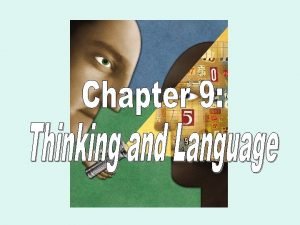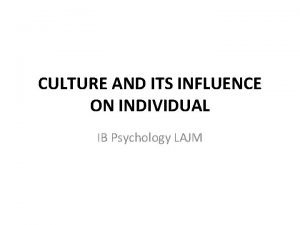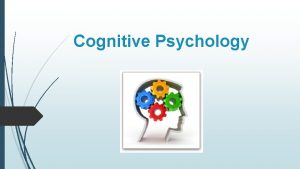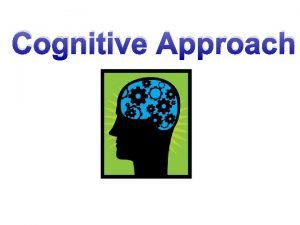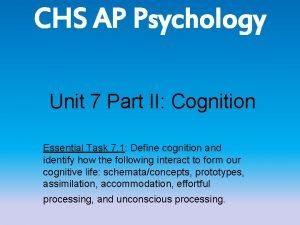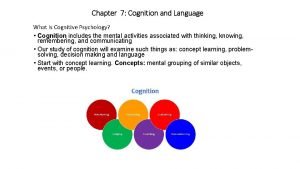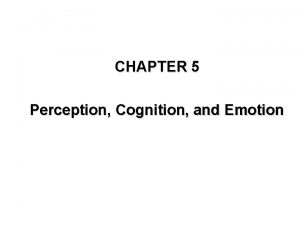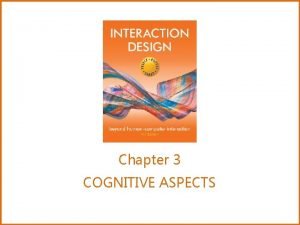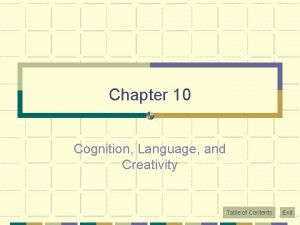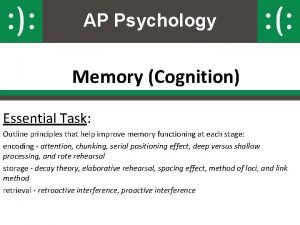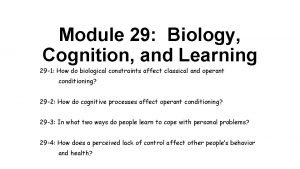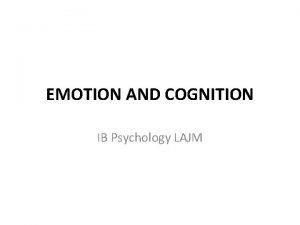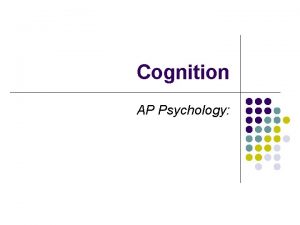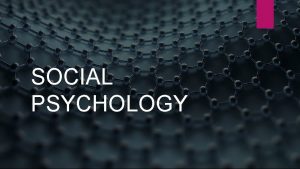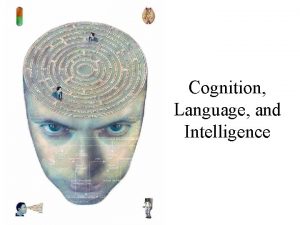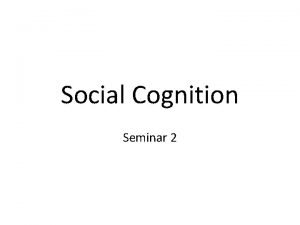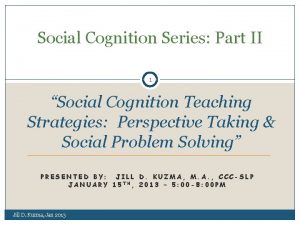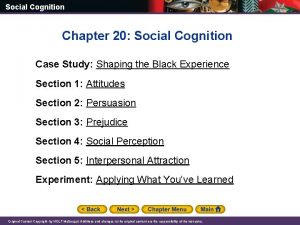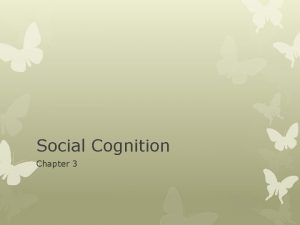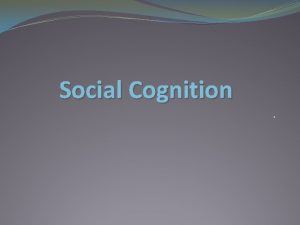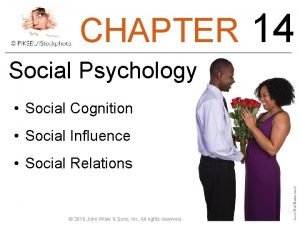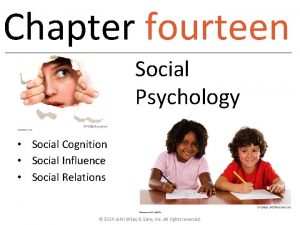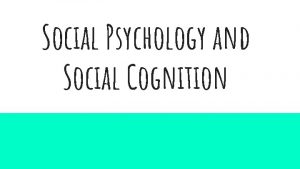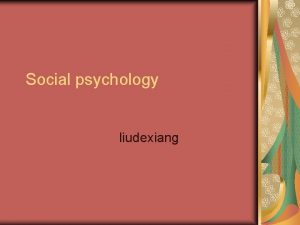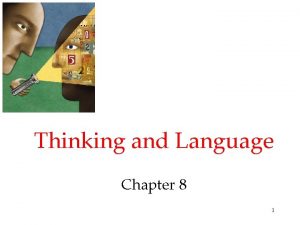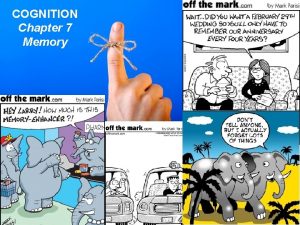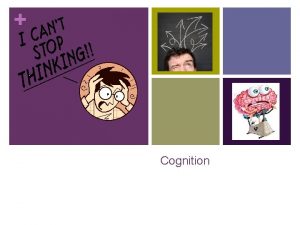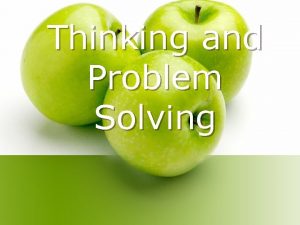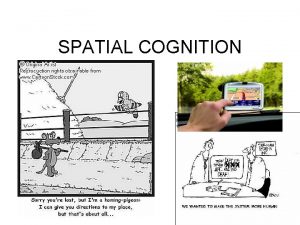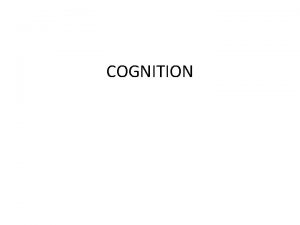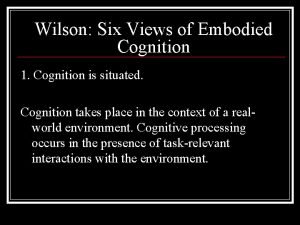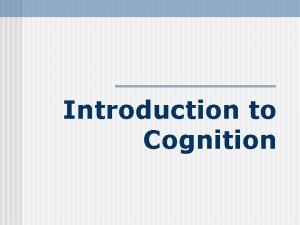Lecture 3 Social Cognition Social Cognition Outline n

























- Slides: 25

Lecture 3 Social Cognition

Social Cognition: Outline n n Introduction Controlled and Automatic Processing n n Schemas n n Ironic Processing Advantages and disadvantages Perseverance Self-fulfilling prophecy Mental Shortcuts: Heuristics n n Representativeness Availability Anchoring and adjustment Simulation

Controlled and Automatic Processing n Automatic processing n n Thinking that is nonconscious, unintentional, involuntary, and effortless Controlled processing n Thinking that is conscious, intentional, voluntary and effortful Beware of the Overconfidence Barrier!

Ironic processing n Attempts to suppress thoughts may lead to hyper-accessibility of those thoughts n For the next minute, do not think of a white bear.

Schemas n What is a schema? n n A schema is an organized configuration of knowledge, based on past experience, that we use to interpret our current experience. Related concepts include prototypes, stereotypes, and scripts

Schemas (Continued): Advantages and Disadvantages of Schematic Processing n Advantages n n Helps us to remember and organize information Helps to interpret and evaluate new and/or ambiguous information Speeds up processing time Disadvantages n n May be overly accepting of information that fits a schema but it is not correct May lead to inaccurate expectancies

Schemas (Continued) n Perseverance effect n n Social beliefs persist even when contrary evidence is presented See Ross, Lepper, & Hubbard, 1975

Schemas (Continued) n Self-fulfilling prophecy n n n A person has an expectation about what another person is like Influences how the first person acts towards the second person The second person behaves consistently with the first person’s expectation

Schemas (Continued) Self-Fulfilling Prophecy (Rosenthal & Jacobson, 1968) n n n Random assignment to groups Experimental group was designated “spurters” or “bloomers” At the end of the school year, “bloomers” outperformed peers in the control group.

Mental Shortcuts: Cognitive Heuristics (Tversky & Kahneman, 1973; 1974; 1982) n The Representativeness Heuristic -- the tendency to judge membership in a group by how well a particular instance matches a prototype or representative example of the group Related phenomena 1. Base-rate fallacy tendency to ignore relevant statistical information about the average frequency, and instead be influenced by distinctive features of the case at hand. 2. Gambler’s fallacy The failure to recognize the independence of unconnected chance events.

Mental Shortcuts (Continued) n The Availability Heuristic - using the ease of remembering examples or the amount of information you can quickly remember as a guide to making an inference. Related phenomena 1. False consensus bias The tendency to overestimate the number of other people who are similar to us 2. Priming effect The influence of earlier experience on subsequent impressions or thought

Mental Shortcuts (Continued) n The Anchoring and Adjustment Heuristic - the process of estimating some value by starting with some initial value and then adjusting it to the new instance. Related phenomena 1. Framing effect The tendency to let the way in which information is presented affect the judgment we make. 2. Contrast effect If given a contrast, tend to exaggerate characteristics of the object in the opposite direction.

Mental Shortcuts (Continued) n The Simulation Heuristic - the ease with which you can imagine a particular scenario with a particular ending. Related phenomena 1. Counterfactual Thinking The creation of alternatives “realities” to what actually occurred.

Counterfactual Thinking: “What might have been” n Upward counterfactuals n n Imagined outcomes that are better than reality Downward counterfactuals n Imagined outcomes that are worse than reality

Causal Attributions n Causal attribution theories are a group of theories that describe how people explain why a given behaviour occurred.

Causal Attributions Heider (1958) n Internal attribution n n An attribution to a personal characteristic of an actor (e. g. , ability, mood, personality, etc. ) External attribution n An attribution to a situational factor, outside the actor (e. g. , luck, task, etc. )

Causal Attributions n Correspondent Inference Theory (Jones & Davis, 1965) n n n Choice Expectedness Effects

Causal Attributions n Covariation Model (Kelley, 1967) n Consensus n n Distinctiveness n n Information about the extent to which other people behave the same way as the actor does toward the same stimulus Information about the extent to which one particular actor behaves the same way to different stimuli Consistency n Information about the extent of which the behaviour between one actor and one stimulus is the same across time and circumstances.

Causal Attributions: Kelley’s Covariation Model Consensus Low: Others do not rave about the film Distinctiveness + Low: The stranger raves about many other films + Consistency Attribution High: The stranger always raves about this film = Internal (Personal) Attribution The stranger caused the behaviour = External (Stimulus) Attribution The film caused the behaviour The stranger raves about the film High: Others rave about the film + High: The stranger does not rave about many other films + High: The stranger always raves about this film.

Causal Attributions n The Fundamental Attribution Error (Heider, 1958) n The tendency to focus on the role of personal causes and underestimate the impact of situations on other people’s behaviours.

Causal Attributions

Causal Attributions

Causal Attributions n The Actor/Observer Bias n The tendency to attribute our own behaviour to situational causes and the behaviour of others to personal factors.

Causal Attributions n Self-Serving Bias n Explanations for one’s successes credit internal, dispositional factors and explanations for failures blame external, situational factors.

Causal Attributions n Defensive Attributions n Help us to avoid feelings of vulnerability and morality n Unrealistic Optimism n n The belief that good things are more likely to happen to oneself than to peers and bad things are more likely to happen to peers than to oneself. Belief in a Just World n The belief that people get what they deserve in life, such that good things happen to good people and bad things happen to bad people.
 01:640:244 lecture notes - lecture 15: plat, idah, farad
01:640:244 lecture notes - lecture 15: plat, idah, farad Konsep ketersediaan heuristik
Konsep ketersediaan heuristik Lecture outline example
Lecture outline example Lecture outline example
Lecture outline example Lecture outline example
Lecture outline example Lecture outline meaning
Lecture outline meaning Sandwich sentence writing
Sandwich sentence writing Cognition refers to
Cognition refers to Mental.status exam
Mental.status exam Mse in counseling
Mse in counseling Odden and rochat
Odden and rochat What is cognition
What is cognition Cognition definition
Cognition definition Mental set ap psychology
Mental set ap psychology Chapter 7 cognition thinking intelligence and language
Chapter 7 cognition thinking intelligence and language What is cognition
What is cognition Objectives of perception
Objectives of perception Altered cognition in older adults is commonly attributed to
Altered cognition in older adults is commonly attributed to What is cognition
What is cognition Cognition definition
Cognition definition Priming psychology example
Priming psychology example Unit 7 cognition
Unit 7 cognition Module 29 biology cognition and learning
Module 29 biology cognition and learning Teacup ib psychology
Teacup ib psychology Embodied cognition ap psychology definition
Embodied cognition ap psychology definition Representativeness heuristic
Representativeness heuristic







